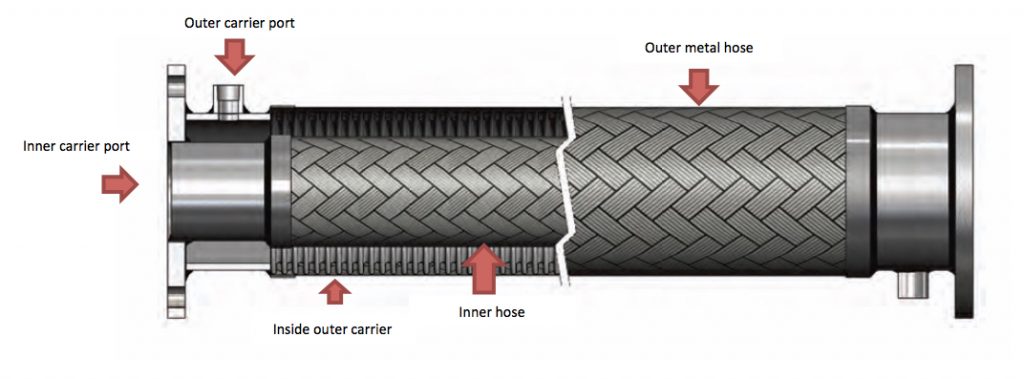Is a Jacketed Hose Assembly the Right Choice?
By: Julie Germano | On: October 26, 2016
Jacketed Hose Assemblies are Right for any Application with Media that Must be Kept at an Elevated, Constant or Controlled Temperature
Jacketed assemblies are designed to handle viscous or corrosive media such as asphalt and sulfur. They are often used in asphalt and hot mix plants, in the food and beverage industries and for cosmetic and pharmaceutical applications. Jacketed assemblies –a “hose within a hose” – consist of a flexible metal inner core hose and a larger diameter flexible metal jacket – outer core hose. The hoses are joined at the ends with fittings that eliminate any media pathway between the two hoses, allowing the hoses to act independently as separate fluid carriers. To keep viscous material in the inner hose hot and easily conveyed, steam or hot oil circulates through the jacket hose. Additionally, jacketed hoses are designed for secondary containment solutions for liquids and gases.

Use Jacketed Assemblies to Install Into a Jacketed System
When installing the typical jacketed hose assembly into a jacketed system, the link between the jacketed components is critical to effectively transfer the steam, coolant, or vacuum between the jacketed components in such a way to ensure a sealing engagement is maintained between the jacketed assembly (inner and outer hoses) and jacketed system. Port couplings in the outer hose provide a means to transfer the jacket media between components. In a jacketed assembly, the outer hose is filled with cold media, which acts as an insulator to reduce heat transfer conditions when it is desirable to keep the temperature of the inner hose contents in a relatively cold state.
Jacketed Hoses are Effective for Cryogenic Applications
Oxygen, nitrogen, and argon, are often used in industrial and medical applications, and jacketed assemblies can be used for the cryogenic transfer of these liquids. Other applications of cryogenics have included fast freezing of foods and the preservation of biological materials. Cryogenic hoses are usually insulated by a vacuum being pulled in the outer hoses.
Cryogenic hoses are used for ship to shore transfer, road tanker, rail tanker and in plant applications requiring low-temperature flexibility, strength, safety and consistency. Cryogenic technology is commonly used in the production of liquefied natural gas (LNG) for use as a fuel and feedstock for various petrochemicals.
Over the years the term cryogenics (Greek origin: “kyros” meaning frost and “genic” meaning to produce) has been used to refer to temperatures below approximately -150 C. The National Institute of Standards and Technology has chosen to consider the field of cryogenics at temperatures below −180 °C or −292.00 °F or 93.15 K.
The common permanent gases shown in the table below change from gas to liquid at atmospheric pressure at the temperatures shown, called the normal boiling point (NBP). These liquids are known as cryogenic liquids or cryogens.

Jacketed Assemblies for Insulation, Worker Safety, Protection from Mechanical Damage
For serious transfer applications, the containment of the media is critical in case of rupture of the inner hose. If the inner hose containing the hazardous media leaks, the leak will be caught by the jacket hose instead of escaping into the environment. In some applications, a vacuum is created in the jacket hose and a leak detection system is installed to detect whenever media escapes from the inner hose into the jacket hose by sensing changes in pressure.
For more information about jacketed assemblies, please contact our Inside Sales team or call us at 800-221-2319 or and one of our sales representatives will be happy to assist you!
Copyright 2016, Hose Master, LLC
All Rights Reserved

